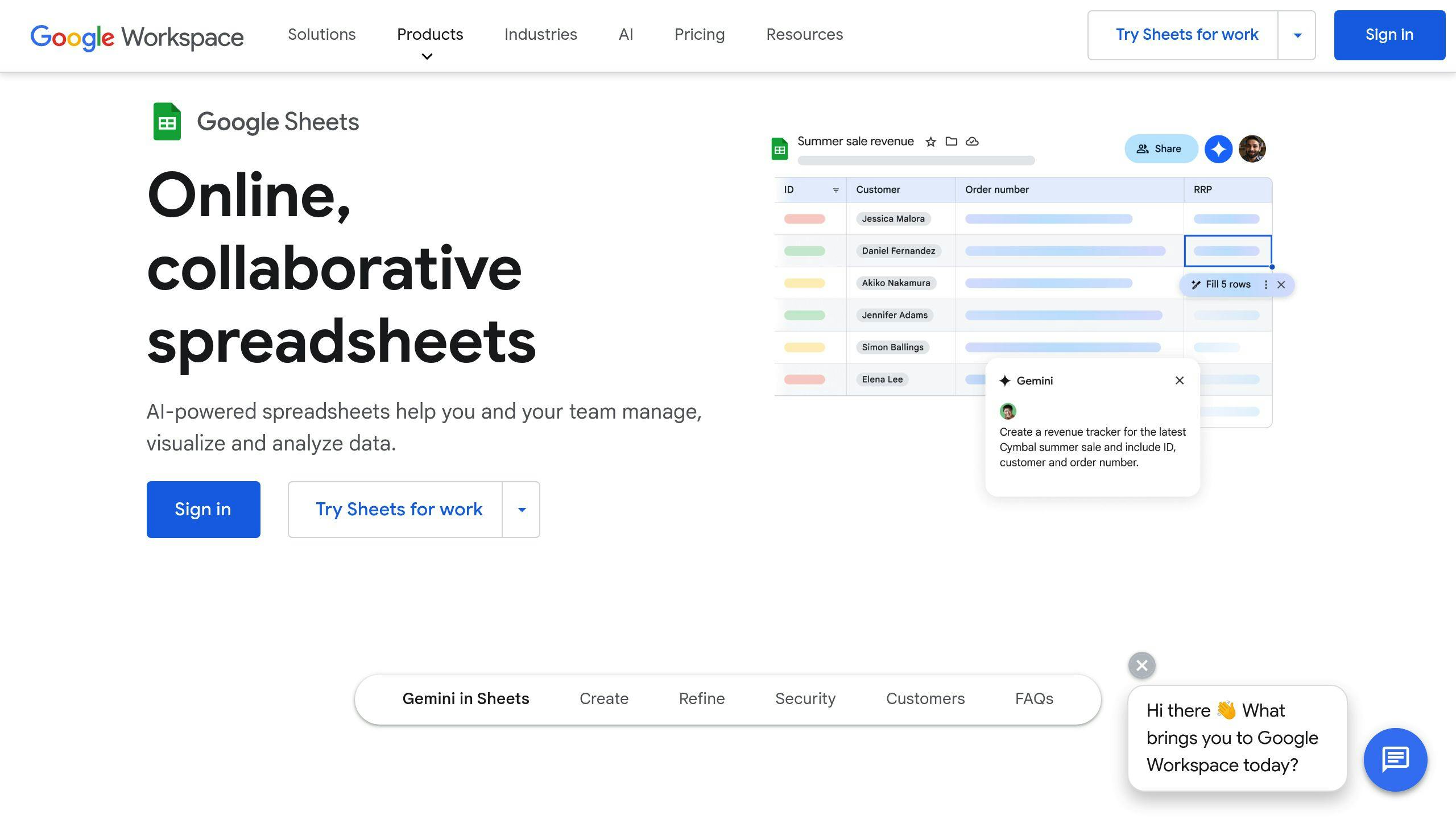An email content calendar is essential for organizing and streamlining email marketing efforts. It helps schedule campaigns, align with marketing goals, and maintain consistent communication with your audience. Here’s a quick summary of the key points:
- What is it? A tool to plan and track email campaigns, including timelines, themes, audience segments, and performance metrics.
- Why use it? Ensures timely delivery, personalized messaging, and better resource management.
- How to create one?
- Set clear, measurable goals (e.g., increase leads by 20% in 3 months).
- Understand your audience through data like purchase history and engagement stats.
- Choose tools like Google Sheets (small teams) or platforms like Mailchimp (larger teams).
- Plan campaigns around key dates and leave room for flexibility.
- Key features: Campaign details (name, goals, send date), task assignments, and performance tracking.
To keep your calendar effective, update it regularly, segment your audience, and use A/B testing for optimization. Tools like Google Sheets or email platforms with built-in calendars (e.g., HubSpot) can simplify the process. A well-maintained calendar leads to higher engagement, better targeting, and improved campaign results.
How to Create an Email Marketing Content Calendar
Steps to Create an Effective Email Content Calendar
Learn how to set up a calendar that keeps your email marketing organized and helps you achieve your goals.
Set Your Email Marketing Goals
Start by defining clear, measurable goals for your email campaigns. Here are some examples:
| Goal Type | Example Target | Timeframe |
|---|---|---|
| Lead Generation | Increase leads by 20% | Quarterly |
| Customer Retention | Lower churn by 15% | 6 months |
| Brand Awareness | Raise open rates to 25% | Monthly |
| Sales Growth | Generate $50K in email revenue | Quarterly |
Once your goals are outlined, focus on understanding your audience to create messages that truly connect.
Know Your Audience
Dig into subscriber data to uncover patterns in their behavior and preferences. Build detailed personas by examining:
- Purchase history and browsing habits
- Email engagement stats (opens, clicks, etc.)
- Demographic details
- Topics and content they interact with most
This information will guide your messaging and improve your campaign's impact.
Choose Tools for Your Calendar
Select tools that match your team's size and workflow. Here are some options:
| Tool Type | Best For | Key Features |
|---|---|---|
| Google Sheets | Small teams | Simple collaboration, easy tracking |
| CoSchedule | Mid-size teams | Integrations, visual planning |
| StoryChief | Large teams | Advanced automation, workflows |
With the right tool in place, you’re ready to organize campaigns around key dates and content needs.
Schedule Content Around Key Dates and Types
Plan your campaigns based on important dates and ensure a good mix of content. For example:
- Holiday Promotions: Schedule these well in advance to allow time for review and testing.
- Recurring Emails: Keep newsletters and other regular emails on a consistent schedule.
- Flexible Content: Leave room for last-minute announcements, product launches, or special offers.
This approach ensures your calendar stays organized while allowing for adaptability when needed.
Key Elements of an Email Content Calendar
A well-organized email content calendar includes specific components to keep your campaigns running smoothly. Let’s break down the key pieces that make it a valuable marketing tool.
Details for Each Campaign
Each campaign in your calendar should include detailed information to ensure everything runs as planned. Here's what to include:
| Campaign Element | Description | Purpose |
|---|---|---|
| Campaign Name | A unique identifier (e.g., "Spring2025-NewCollection") | Makes tracking and referencing easy |
| Send Date/Time | Exact schedule for the email | Ensures timely delivery |
| Target Audience | Specific segment or group | Helps tailor content effectively |
| Subject Line | Email header and preview text | Boosts open rates |
| Campaign Goals | Clear, measurable objectives | Tracks success and improves future strategies |
| Content Type | Type of email (e.g., newsletter, promotion, announcement) | Allocates resources appropriately |
Assign Tasks
To avoid delays, assign clear roles and responsibilities. This ensures each part of the process moves forward without hiccups. Key roles include:
- Content Creation: Writers, designers, or video producers craft the message.
- Quality Assurance: Proofreaders and testers review for errors or inconsistencies.
- Technical Setup: Email builders and automation specialists handle the technical side.
- Performance Monitoring: Analytics teams track results and suggest improvements.
Using tools like Asana or Trello can help you manage deadlines, track progress, and ensure accountability across the team.
Build in Flexibility
Set aside about 20% of your calendar for last-minute changes or opportunities. This extra space allows you to:
- Respond to sudden industry shifts
- Handle unexpected business updates
- Launch time-sensitive promotions
- Adjust campaigns based on performance insights
To stay organized, consider adding a "Rapid Response" section to your calendar. This gives you a dedicated place to manage unplanned content without disrupting the rest of your schedule.
sbb-itb-6e7333f
Tips for Keeping Your Email Content Calendar Updated
Keeping your email content calendar up-to-date takes regular effort and thoughtful adjustments. Here’s how you can keep it organized and effective.
Regularly Review and Update
Set aside time each month or quarter to review your email calendar and make sure it aligns with your goals. A structured review process can help you stay on track:
| Review Element | Frequency | Key Focus Areas |
|---|---|---|
| Performance Metrics | Weekly | Open rates, click-through rates, and conversions |
| Content Alignment | Monthly | Brand messaging, campaign goals, seasonal themes |
| Resource Allocation | Quarterly | Team capacity, content needs, and technical support |
| Strategy Assessment | Quarterly | Goal tracking, ROI evaluation, and areas to improve |
Regular reviews allow you to adjust your approach to meet changing business goals and audience preferences.
Use Audience Segmentation
To make your emails more relevant, divide your audience into smaller groups based on:
- Behavioral Data: Look at purchase history, website activity, and email engagement.
- Demographics: Think about factors like age, location, or job role.
- Customer Journey Stage: Customize emails for awareness, consideration, or loyalty stages.
Tailored content ensures your messages resonate better with each group.
Plan for A/B Testing
After aligning your calendar with your goals and audience, A/B testing can help you fine-tune your strategies. Focus on these areas for the best results:
- Subject Lines: Test different versions to boost open rates.
- Send Times: Experiment with delivery times to find what works best.
- Content Layout: Compare email designs and formats for better engagement.
- Call-to-Action: Try out different button placements and wording.
Record what works and use those insights to improve future campaigns. Automation tools can make the testing process more efficient and ensure consistent tracking of results.
Tools and Resources for Managing Email Content Calendars
Once you've grasped the basics of an email content calendar, it's time to look at tools that can make managing it easier and more efficient.
Google Sheets and Microsoft Excel

Google Sheets and Microsoft Excel are great options for straightforward email calendar management. They offer basic features like templates, sharing options, and customization, making them accessible for teams of all sizes. Plus, they’re budget-friendly and easy to use.
Email Marketing Platforms with Built-In Calendars
Platforms like Mailchimp, HubSpot, and Constant Contact take email calendar management to the next level. These tools come with features like visual scheduling, automation, and CRM integration. They’re designed to simplify the process while keeping your campaigns organized.
Another bonus? Many of these platforms integrate seamlessly with project management tools and CRM systems, helping unify your marketing efforts. Built-in analytics also make it easy to measure campaign performance and refine your strategy over time.
Email Service Business Directory
Looking for something more tailored to your needs? The Email Service Business Directory is a curated resource that lists various platforms and services. It organizes options by features and pricing, helping you find solutions that fit your goals and budget.
With the right tools in place, managing an email content calendar becomes a smooth and efficient process, giving you more time to focus on creating impactful campaigns.
Conclusion and Key Points
An email content calendar turns scattered efforts into well-organized, impactful campaigns. To create a strong calendar, focus on three main elements: setting clear goals that align with your marketing strategy, understanding your audience to craft focused content, and streamlining your execution process.
To get the most out of your email content calendar:
- Schedule regular reviews: Set up monthly check-ins to analyze performance, spot trends, and find areas for improvement.
- Leave room for flexibility: Keep about 20% of your calendar open for unexpected campaigns or urgent updates.
- Use automation tools: Take advantage of scheduling features to maintain consistency without extra effort.
Tracking metrics like open rates, click-through rates, and conversion rates helps you fine-tune your strategy over time. This data-driven approach ensures that your campaigns keep improving and delivering better results.
The benefits of a well-planned email content calendar include:
- Higher engagement
- Stronger customer connections
- Efficient use of resources
- Consistent brand communication
- Improved campaign outcomes
FAQs
How to create an email marketing calendar?
Building an email marketing calendar takes some planning and organization. Here's how you can get started:
1. Plan Your Campaigns
Include a variety of campaign types to maintain a good balance. Think about promotional emails, newsletters, automated sequences, and seasonal content. This ensures you're prepared for both scheduled and spontaneous opportunities.
2. Organize Your Calendar
Your calendar should include key details like campaign names, target audience segments, send dates, deadlines, and performance metrics. Here's a quick breakdown of some essential components:
| Calendar Component | Purpose |
|---|---|
| Testing Schedule | Plan A/B tests for subject lines and content |
| Performance Metrics | Track open rates, click-throughs, and more |
| Content Update Timeline | Schedule updates based on campaign results |
3. Pick the Right Tools
The tools you choose depend on your team's size and workflow. Smaller teams might prefer simple solutions like Google Sheets, while larger teams may benefit from platforms with built-in features. Options include:
- Google Sheets or Microsoft Excel for straightforward tracking.
- Email marketing platforms with calendar features (e.g., Mailchimp or HubSpot).
- Project management tools that integrate calendars, such as Trello or Asana.
4. Keep It Updated
Regularly review and tweak your calendar to ensure it stays relevant. This can include:
- Monthly performance reviews to track progress.
- Quarterly adjustments to refine your strategy.
- Updating content based on audience feedback or new metrics.


